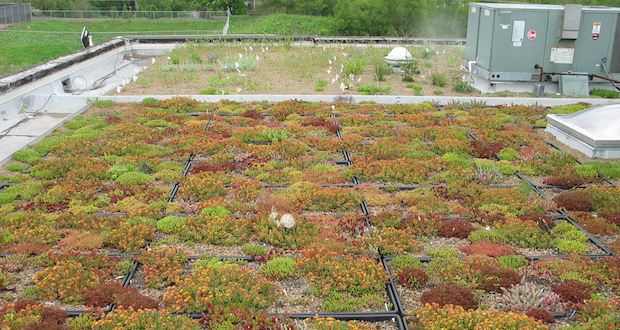Designing Green Roofs to Optimize Stormwater Performance
By David Yocca, FASLA

Green roofs have enormous potential to reduce stormwater runoff, help mitigate problems of urban flooding, and improve water quality in downstream aquatic resources. Following the completion of the Chicago City Hall green roof pilot project in 2001, which was Conservation Design Forum’s first foray into green roof applications, we undertook a green roof study.
This study, located in Elmhurst, Ill., near Chicago, was intended to explore the stormwater performance of standard green roof systems. We wanted to closely examine the fundamental components and elements of green roof systems to better understand their stormwater characteristics so that we could better calibrate and optimize overall site stormwater performance/balance in our projects.
The study entailed a complete replacement of the existing worn waterproofing system with a new waterproofing membrane and green roof. The green roof was installed on the entire 5,730 square feet of roof area on the 1- and 2-story building, except for a small control area. Several different proprietary green roof systems were installed, and represented what were then most of the available products on the market in the Midwest. The roof area was divided into hydrologically isolated plots, with varying systems and depths of growing media — 2 inch, 3 inch, and 8 inch, and with varying drainage materials. Eight of the plots were set up for stormwater monitoring, most of which were planted with the same mix of sedums- one plot was planted with a pre-grown sedum mat, and the 8-inch roof depth was planted with perennials and vegetables as a demonstration garden. Irrigation was not installed, and the only portion of the roof that received supplemental water over and above rainfall was the 8-inch portion to support the vegetables.
We sought and received support funding through an EPA Section 319 grant, which allowed us to pay for specialized monitoring equipment and software. This allowed us to measure runoff from each of the distinct plots following every rainfall event for approximately two years. The grant was focused on non-point source pollution reduction, demonstration/education for green roofs, and performance monitoring. The green roof was installed and maintained during the life of the study by Conservation Land Stewardship (CLS), housed within the same building.
The results were very enlightening for us, confirming some assumptions and dispelling others:
- Smaller rainfall events (typically less than 0.25 inches of rainfall in an 8-hour period) resulted in zero runoff;
- Larger events, and/or events immediately following another rain event, produced runoff, but at a reduced volume and peak discharge time;
- Generally, the systems with deeper growing media retained more water than the thinner systems;
- Approximately 75 percent of the total annual runoff volume was attenuated entirely on the green roof.
We also observed anecdotally that the building’s upper floor was noticeably quieter (it is situated across the street from a busy rail line). Annual energy use fell by approximately $1,400, or about 15 percent, with the addition of the green roof. Our staff loved having a small “community” garden space to grow flowers and vegetables, and go out onto for breaks and lunches.
We have since designed a number of green roofs as part of an overall approach to balancing rainwater on-site to the degree possible, and continue to explore the potential to benefit from green roof performance at the site, neighborhood, and community scale. Green roofs clearly play a critical role in urban stormwater mitigation, and equally clear is the need for further research and ongoing monitoring of stormwater performance on green roofs in different climactic regions.
David Yocca, FASLA, is a senior partner and principal landscape architect at Conservation Design Forum (CDF), and a member of the Board of Directors for Green Roofs for Healthy Cities. CDF is a restorative planning, design, and engineering firm.
This article originally appeared in Living Architecture Monitor, the official publication of Green Roofs for Health Cities, and is reprinted here by permission. For more information, visit www.livingarchitecturemonitor.com.
FIND OUT MORE
- Final Report on the EPA 319 Grant and Project: http://www.cdfinc.com/
- Article on CDF Green Roof Study by Bruce Dvorak: https://www.researchgate.net/profile/Bruce_Dvorak2/publication/258310905_Green_Roof_Test_Plots_A_Green_Roof_Comparison_Project_The_Illinois_EPA-CDF_Green_Roof/links/546a51f40cf2397f783016b5.pdf


